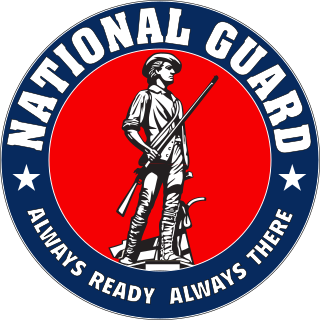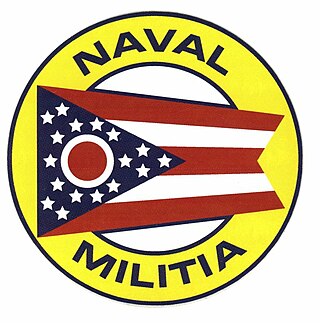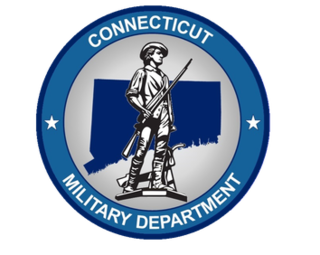
The National Guard is a state-based military force that becomes part of the reserve components of the United States Army and the United States Air Force when activated for federal missions. It is a military reserve force composed of National Guard military members or units of each state and the territories of Guam, the Virgin Islands, Puerto Rico, and the District of Columbia, for a total of 54 separate organizations. It is officially created under Congress's Article 1 Section 8 ability to "raise and support armies". All members of the National Guard are also members of the organized militia of the United States as defined by 10 U.S.C. § 246. National Guard units are under the dual control of state governments and the federal government.

The Posse Comitatus Act is a United States federal law signed on June 18, 1878, by President Rutherford B. Hayes which limits the powers of the federal government in the use of federal military personnel to enforce domestic policies within the United States. Congress passed the Act as an amendment to an army appropriation bill following the end of Reconstruction and updated it in 1956, 1981 and 2021.

A commander-in-chief or supreme commander is the person who exercises supreme command and control over an armed force or a military branch. As a technical term, it refers to military competencies that reside in a country's executive leadership, a head of state, head of government, or other designated government official.

In the United States, state defense forces (SDFs) are military units that operate under the sole authority of a state government. State defense forces are authorized by state and federal law and are under the command of the governor of each state, ,.

The Coast Guard Administration of the Ocean Affairs Council, also known as the Taiwan Coast Guard or R.O.C. Coast Guard, is charged with maintaining law and order, protecting the resources of the territorial waters of the Republic of China (Taiwan), which surrounds Taiwan, Penghu, Kinmen, Matsu Islands, Green Island, Orchid Island, Pratas Island (Tungsha/Dongsha), and Nansha Islands as well as providing a first line of defense along coastal areas against smugglers and illegal immigrants. The CGA is considered a civilian law enforcement agency under the administration of the Ocean Affairs Council of the Executive Yuan, though during emergencies it may be incorporated as part of the Republic of China Armed Forces.

A naval militia is a reserve military organization administered under the authority of a state government in the United States. It is often composed of reservists of the Navy Reserve, Marine Corps Reserve, and Coast Guard Reserve, retirees and volunteers. They are distinguishable from the U.S. Coast Guard Auxiliary which is a federally chartered civilian volunteer component of the U.S. Coast Guard and falls under the command of the Commandant of the Coast Guard through the Chief Director of the Auxiliary, and the United States Maritime Service and United States Merchant Marine, both of which are federal maritime services.

The Ohio Naval Militia (Ohio Navy) is the naval militia of the State of Ohio. It is the naval arm of the State of Ohio's Adjutant General's Department, and is part of Ohio's military forces.

The Insurrection Act of 1807 is a United States federal law that empowers the president of the United States to deploy U.S. military and federalized National Guard troops within the United States in particular circumstances, such as to suppress civil disorder, insurrection, or rebellion.

The New York State Division of Military and Naval Affairs is responsible for the state's New York Army National Guard, New York Air National Guard, New York Guard and the New York Naval Militia. It is headed by Adjutant General of New York Major General Raymond F. Shields Jr., appointed on October 1, 2018. with the Governor of New York Kathy Hochul serving as Commander in Chief of the state's militia forces. It is part of the New York State Executive Department.

The New York Naval Militia is the naval militia of the state of New York, and is under the authority of the Governor of New York as Commander-In-Chief of the state's military forces. With the New York Guard, the New York Army National Guard and New York Air National Guard, it is under the control of the New York State Division of Military and Naval Affairs and New York's Adjutant General. It is the oldest continuously operating Naval militia in the United States.

The commander-in-chief of the Canadian Armed Forces exercises supreme command and control over Canada's military, the Canadian Armed Forces. Constitutionally, command-in-chief is vested in the Canadian monarch, presently King Charles III. Since the Letters Patent, 1947, were signed by King George VI, the governor general of Canada—presently Mary Simon—executes most of the duties of the sovereign, including in his role as commander-in-chief. Consequently, the governor general also uses the title Commander-in-Chief of the Canadian Forces. By protocol, the title used within international contexts is Commander-in-Chief of Canada.

The militia of the United States, as defined by the U.S. Congress, has changed over time. During colonial America, all able-bodied men of a certain age range were members of the militia, depending on each colony's rule. Individual towns formed local independent militias for their own defense. The year before the US Constitution was ratified, The Federalist Papers detailed the founders' paramount vision of the militia in 1787. The new Constitution empowered Congress to "organize, arm, and discipline" this national military force, leaving significant control in the hands of each state government.

The Ohio National Guard comprises the Ohio Army National Guard and the Ohio Air National Guard. The commander-in-chief of the Ohio Army National Guard is the governor of the U.S. state of Ohio. If the Ohio Army National Guard is called to federal service, then the President of the United States becomes the commander-in-chief. The military commander of all forces in the State of Ohio is the Adjutant General, Major General John C. Harris, Jr. is responsible for the command of 17,000 members, preparedness and readiness, installation management, and budget of the Ohio National Guard. The current Assistant Adjutant General for Army, with responsibility for overseeing the Ohio Army National Guard training and operations, is Brigadier General Thomas E. Moore II. The current Assistant Adjutant General for Air is Major General James R. Camp with responsibility for overseeing the Ohio Air National Guard.

The Connecticut Military Department is a state agency of the government of Connecticut. Its primary components are the Connecticut Army National Guard, the Connecticut Air National Guard, and four companies of the state militia. The Military Department of the State of Connecticut traces its origins to May 11, 1637, when the "General Courts" established a military arm of the provincial government. In 1939, the State's Military Department was established to consolidate the offices of Adjutant General, Quartermaster General, Armory Board, and Armory Board Inspector.

The South Carolina State Guard (SCSG) is the designated state defense force for the state of South Carolina.

The Bolivarian Militia of Venezuela, is a militia branch of the National Bolivarian Armed Forces of Venezuela. Its headquarters is at the National Military Museum, Fort Montana, Caracas. The Commanding General of the National Militia is Major General Carlos Augusto Leal Tellería, Venezuelan Army, as of March 2018. The National Militia celebrates its anniversary every April 13 yearly.

The Adjutant General of Connecticut is the highest-ranking military officer in the Armed Forces of the State of Connecticut which includes the Connecticut National Guard, the four units of the Governor's Guards, the Connecticut State Guard, the Connecticut State Guard Reserve and the Connecticut Naval Militia. The current Adjutant General is Major General Francis J. Evon, Jr. He was appointed to a four-year term effective July 1, 2018.
The Connecticut Naval Militia was a class of militia of the Armed Forces of the State of Connecticut along with the Connecticut National Guard, the Connecticut State Guard, and the Connecticut State Guard Reserve. The Governor of Connecticut is authorized to organize a naval militia as a special force for coastal protection or other appropriate naval services per Connecticut General Statutes. The Connecticut Naval Militia has been inactive for several decades with no current membership.

The Louisiana State Guard (LSG) is the official state defense force of the state of Louisiana. The LSG was first created during World War II. As a state defense force, the LSG is a part of the state militia of Louisiana, and can serve as a stateside replacement of the Louisiana National Guard while the National Guard is deployed. Unlike the Louisiana National Guard, the Louisiana State Guard is solely under state control, and cannot be federalized or deployed outside of Louisiana, guaranteeing additional soldiers will always be available to the governor to deploy in response to crises.
The New Jersey State Guard, previously known as the New Jersey State Militia, is the inactive state defense force of New Jersey, and is one of New Jersey's authorized military forces. The State Guard served as the stateside replacement for the New Jersey National Guard during World War I and World War II when the National Guard was deployed abroad.
















